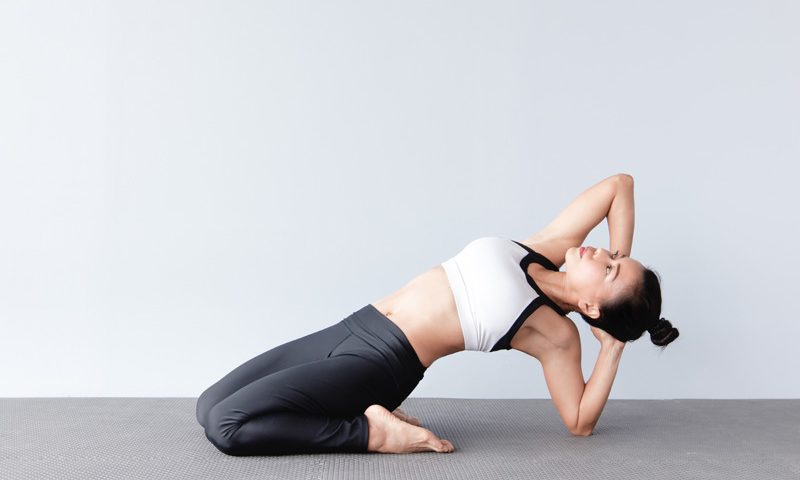
Most Common Questions from Yoga Beginners
October 18, 2018
Your Evening Yoga Routine
November 1, 2018Ways to Soften Your Ashtanga Yoga Practice

Ashtanga is a dynamic yoga practice that synchronizes breathing with movement. The goal of the practice is to produce an internal heat that purifies the body. Ideal for building core strength, Ashtanga strengthens and tones the muscles through various asanas. While the practice has many benefits, it can be physically demanding on the body and mind. For some people, this makes it difficult to practice regularly, particularly for those with physical limitations. Thankfully, there are ways to soften your Ashtanga practice for a lighter workout. In this article, we explore some of these in more detail. For best results, make sure to wear suitable clothing. To stay comfortable, layer a yoga sweater over a loose t-shirt.
Start with Stillness
One of the best ways to soften your practice is to start with stillness. Before you get started, take a few minutes to sit quietly and focus on your breathing. Whether you prefer to count your breath or notice it’s natural rhythm, use this time to create mental space.
The mental space can then be channeled into your Ashtanga and allow you to notice when your breathing starts to slip. When this happens, gently synchronize your breath with your movement once more. As well as improving your practice, synchronized breathing with help you to feel cool, calm, and collected.
Expand your Listening
Once you’ve synchronized your breathing and movement, it’s time to widen your listening. Instead of just noticing the inhale/exhale, pay attention to the space between your breaths, too.
A key part of Ashtanga philosophy is free breathing. In traditional practice, this can be used to link our awareness to the sound of our breath. In modern practice, however, we can become aware of our breathing on a much deeper level.
A great way to widen your listening is to focus on the pauses in between the breaths. When you notice the gaps between the inhale and exhale, you start to expand your connection with your breath. Over time, this creates a softer approach to Ashtanga and allows you to experience the practice in a more complete way. Additionally, noticing the gaps helps to nurture the transition between postures, encouraging fluid movement from one pose to the next.
Learn When to Stop
To soften your Ashtanga practice, it’s important to learn how to let go. Notice when you’re pushing yourself too far and stop. Although we often associate pain with progress, you will progress far quicker if you learn when to stop. To do this, you must listen to your body. When you perform an asana, notice the physical sensations in the body. While a little tightness is expected, you must stop immediately if you feel pain. If you fail to do so, you’re likely to injure the muscles and hinder your progress.
Remember that yoga is a long-term practice. Instead of reaching an end goal, the therapy has no end. The great thing about the practice is that it will continue to nurture your body for as long as you use it.
Slow Down
One of the most obvious ways to soften your practice is to slow down. Instead of rushing to complete the postures, take your time. When we rush, we can lose our focus by moving too quickly. When we take things slow, we can synchronize the breath and movement for a fuller practice. Additionally, slowing down allows us to notice how our body feels. This is a great way to notice pain or discomfort and gives us time to exit the posture before injury occurs.

Remember Why You Started
Finally, remember why you are using yoga. Before each session, take 5 minutes to reflect on your long-term goals and intentions. If you started yoga to better your mental health, remember this before pushing your body too far. Sometimes, taking things slow is far more productive than rushing towards an end result. Give yourself credit for everything you have achieved so far and make sure to enjoy your practice. If there are certain postures you hate, don’t use them! As yoga is a personal practice, it’s all about finding what’s right for you. Build a routine around the asanas that make you feel great.
Soft Ashtanga Poses
Wide-Legged Forward Bend
To practice Wide-Legged Forward Bend, stand tall with your feet 3 inches apart. Next, bend your knees and lean forward, resting your hands on your thighs. At this stage, your torso should remain taller than your back. Stay in this position for a few breaths, noticing your breathing. On the exhale, hinge at the waist and lower your torso toward the mat. Allow your arms to hang freely. You are in Wide-Legged Forward Bend. Hold the position for around 30 seconds before slowly raising yourself back up.
Warrior Pose I
To practice Warrior I, begin by standing tall. Exhale and extend your arms to the side, spreading your feet hip-width apart. Turn your left foot in 90-degrees and your right foot out 45-degrees. Next, bend your right knee while keeping your shin perpendicular to the mat. Finally, rotate your torso to the right and gaze at your right fingertips. You are in Warrior I. Hold the position for around 1 minute, taking time to focus on your breathing.
Chair Pose
To practice Chair Pose, stand straight on the mat with your feet together. As you inhale, lift your arms above your head with your palms facing inward. As you exhale, bend your knees and tilt your upper body over your thighs. Finally, lower your sitting bones towards the ground as if you were sitting in a chair. You are in Chair Pose. Hold the asana for around 30 seconds, keeping your lower back strong throughout.
Hand-to-Big-Toe Pose
To practice Hand-to-Big-Toe Pose, stand tall and rest your hands on your hips. Bending your left leg, use your hands to draw your knee into your stomach. To maintain the position, hold the outside of your left foot. On your next inhale, stretch your left leg forward as much as possible, while keeping ahold of your foot. You are in Hand-to-Big-Toe Pose, hold the asana for 30 seconds before repeating on the other side.
In Summary
While dynamic yoga has its benefits, a softer practice allows you to nurture your body on a deeper level. For a calming environment, fill your studio with scented candles and soft blankets. If you’re still struggling to relax, considering picking up a mindfulness yoga necklace to set the tone.

